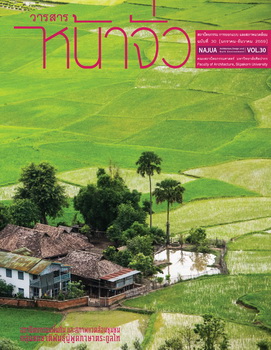พลวัตของภูมิปัญญาในเรือนพื้นถิ่นไทลื้อ ระหว่างถิ่นกำเนิดในเมืองลวง สิบสองพันนา กับบ้านลวงเหนือ-บ้านลวงใต้ อำเภอดอยสะเก็ด จังหวัดเชียงใหม่
Keywords:
สถาปัตยกรรมพื้นถิ่น, ภูมิปัญญา, พลวัต, ไทลื้อ, สิบสองพันนา, เชียงใหม่, Vernacular Architecture, Intellect, Dynamic, Tai-Lue, Xishuangbanna, ChiangmaiAbstract
บทความนี้มุ่งค้นหาพลวัตของภูมิปัญญาในเรือนพื้นถิ่นไทลื้ออันเนื่องมาจากการอพยพย้ายถิ่นฐานระหว่างถิ่นกำเนิดในเมืองลวง สิบสองพันนากับถิ่นอพยพบ้านลวงเหนือ และบ้านลวงใต้ อำเภอดอยสะเก็ด จังหวัดเชียงใหม่ โดยมีวัตถุประสงค์เพื่อค้นหา เปรียบเทียบแบบแผนเรือนพื้นถิ่นไทระหว่างสองพื้นที่และค้นหาพลวัตทางภูมิปัญญา อันเนื่องมาจากปัจจัยต่างๆ ทั้งสภาพแวดล้อม สังคม วัฒนธรรม ฯลฯ เพื่อแสดงถึงพัฒนาการของรูปแบบเรือนพื้นถิ่นไทลื้อ งานวิจัยนี้เป็นวิจัยเชิงคุณภาพ โดยการสำรวจภาคสนามใน สิบสองพันนาและในเชียงใหม่ รวมทั้งสิ้น 6 หมู่บ้าน จำนวน 38 หลังคาเรือน แล้วนำข้อมูลที่ได้จากภาคสนามมาวิเคราะห์เปรียบเทียบกัน ผลการวิจัยแบ่งได้เป็นภูมิปัญญาที่ได้เป็น 5 ประเด็นคือ 1) การตั้งถิ่นฐาน 2) รูปทรงทางกายภาพ 3) โครงสร้างและวัสดุ 4) ผังพื้นและลำดับการเข้าถึงพื้นที่ 5) วิถีชีวิตกับพื้นที่ใช้สอยในเรือน พลวัตที่เกิดขึ้นมาจากปัจจัยที่มีวัฒนธรรมหลักในสองพื้นที่เป็นตัวกำหนด ซึ่งขึ้นอยู่กับความเจริญก้าวหน้าทางเทคโนโลยี การเข้ามาของระบบเศรษฐกิจและค่านิยมในแต่ละสังคม นอกจากนี้ ยังมีปัจจัยจากสภาพแวดล้อม สภาพอากาศที่ส่งผลให้ชาวไทลื้อต้องปรับตัวเพื่อความอยู่รอด งานวิจัยนี้ชี้ให้เห็นถึงพัฒนาการเพื่อเป็นแนวทางในการอนุรักษ์เรือนพื้นถิ่นไทลื้อให้มีความเหมาะสมกับรูปแบบวัฒนธรรมที่ผสมกลมกลืนและการดำรงไว้ซึ่งอัตลักษณ์ทางวัฒนธรรมด้วย
Dynamic aspects of folk wisdom associated with vernacular Tai-Lue dwellings at the place of origin in Mueang Luang, Xishuangbanna, and Baan Luang Nuea - Baan Luang Tai in Doi Saket District, Chiangmai Province
Inthanon Sookkree
Master of Architecture Program, Faculty of Architecture, Chiangmai University
Rawiwan Oranratmanee
Faculty of Architecture, Chiangmai University
This article looks at the dynamic aspects of folk wisdom associated with traditional dwellings of Tai-Lue people who have in the past, migrated from their place of origin in Mueang Luang, Xishuangbanna, to Baan Luang Nuea and Baan Luang Tai in Doi Saket district of Chiangmai province. The objectives of the investigation are to study and compare the characteristics of houses in the two different locations (place of origin and place of migration) in order to understand the dynamic aspects of folk wisdom under various influencing factors such as environment, society and culture, among others, that could explain the changes in house-form of traditional Tai Lue dwellings. The research is of qualitative nature with fieldworks carried out in Xishuangbanna and Chiangmai. Altogether, 38 dwelling units in 6 villages were studied and comparative analyses of information collected from field surveys were carried out. The outcome led to identifying associated folk wisdoms which could be grouped in terms of the following: 1) setting up the settlement; 2) physical from and characteristics; 3) structure and construction materials; 4) planning and spatial organization; 5) way of life and use of domestic spaces. As a result, the dynamic quality of folk wisdom can be said to concern cultural aspects of the two different locations and is related to technological changes, introduction of new economic system, different social values, and influence of the physical environment, in adapting to survive. In conclusion, the research provides an account of the development process that took place. This can be used to set appropriate guidelines for preserving vernacular characteristics of Tai-Lue houses within the context of cultural assimilation while still retaining certain cultural identity.





